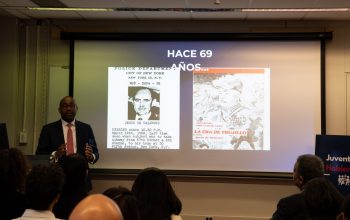news
Presentation on National Plan to Convert to Energy Efficient Traffic Lights
January 25, 2008
Global Foundation for Democracy and Development (GFDD) and Fundación Global Democracia y Desarrollo (FUNGLODE) presented the Seminar, “Opportunities for Sustainable Energy in the Dominican Republic,” on January 17, 2008, at FUNGLODE Headquarters in Santo Domingo, as part of the First International Energy Week.
During the Seminar, Rafael Tobías Crespo, General Director of Land
Transit for the Ministry of Public Labor (Tránsito Terrestre de la Secretaría de Obras Públicas) discussed the changes being introduced in the traffic light system in Santo Domingo and the rest of the country, as part of the energy plan put forth by President Leonel Fernández. Under the plan, high-energy consuming light bulbs will be replaced with energy efficient light-emitting diode bulbs (LED), decreasing both energy consumption and required
financial investment. 10,000 incandescent light bulbs will be replaced with the low-voltage LED bulbs. Unlike incandescent bulbs that utilize ninety percent of the energy they consume for producing heat and a mere ten percent for producing light, the light-emitting diode bulbs identify the semiconductor devise that emits quasi-monochromatic light, resulting in a ten percent reduction in energy consumption for traffic lights that utilize this type of technology.
Transit for the Ministry of Public Labor (Tránsito Terrestre de la Secretaría de Obras Públicas) discussed the changes being introduced in the traffic light system in Santo Domingo and the rest of the country, as part of the energy plan put forth by President Leonel Fernández. Under the plan, high-energy consuming light bulbs will be replaced with energy efficient light-emitting diode bulbs (LED), decreasing both energy consumption and required
financial investment. 10,000 incandescent light bulbs will be replaced with the low-voltage LED bulbs. Unlike incandescent bulbs that utilize ninety percent of the energy they consume for producing heat and a mere ten percent for producing light, the light-emitting diode bulbs identify the semiconductor devise that emits quasi-monochromatic light, resulting in a ten percent reduction in energy consumption for traffic lights that utilize this type of technology.
The traffic lights with the LED system, explained the General Director, can also function all day without interruptions in service. Their design is equal to traditional traffic lights. The radical difference is the form in which they produce energy.
The system not only translates into a more cost effective method of illuminating traffic signals, it also consistently maintains itself,
reducing both traffic jams and fossil fuel expenses. The transit specialist maintained that while the price of petroleum per barrel is increasing, the price of vehicle parking is also significantly increasing. He cited official figures indicating a ten percent annual growth rate. According to Crespo, there are currently more than two million vehicles, 300,000 of which are fuel reliant.
reducing both traffic jams and fossil fuel expenses. The transit specialist maintained that while the price of petroleum per barrel is increasing, the price of vehicle parking is also significantly increasing. He cited official figures indicating a ten percent annual growth rate. According to Crespo, there are currently more than two million vehicles, 300,000 of which are fuel reliant.
Such problems contribute to street congestion,
making it difficult to synchronize traffic lights due to disruptions in energy service. He added the cost of transit to the list of problems. “It isn’t adequate and it does not correspond with reality,” he stated, adding that greater effort should also be made to guarantee that lanes are maintained exclusively for buses, in order to alleviate congestion.
making it difficult to synchronize traffic lights due to disruptions in energy service. He added the cost of transit to the list of problems. “It isn’t adequate and it does not correspond with reality,” he stated, adding that greater effort should also be made to guarantee that lanes are maintained exclusively for buses, in order to alleviate congestion.
Positive aspects of the LED system:
- Does not contribute to global warming
- Lesser maintenance costs
- Greater operative security
- Eliminates the “ghost” effect
- Ultra violet rays do not affect the color of the lights
- Rapid recuperation of investment
- Water and dust resistant
- 15-25 year life expectancy
- Estimated
failures less than 3% after 200,000 hours of operation
GFDD and FUNGLODE carry-out projects and programs that promote energy conservation as part of their overall mission to increase understanding of global warming and the steps that can be taken to mitigate its effects.
Related link:







